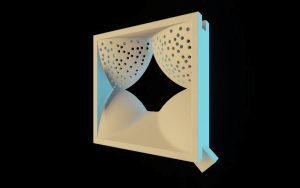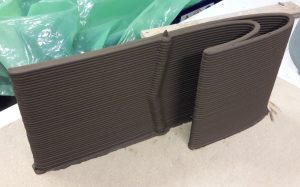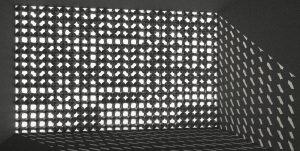Volumetric Modeling for Building Envelopes
Benjamin Dillenburger and Mathias Bernhard
The workshop Performative Porosity at Poli USP (PCC6003) was led by Dr. Mathias Bernhard with Prof. Dr. Benjamin Dillenburger during his USP Cathedara Future Construction (Cátedra Construindo o Amanhã). It was hosted by Prof. Dr. Vanderlay John, and Prof. Dr. Rafael Pileggi and Diana Csillag.
Computational design instruments and digital fabrication processes advance at a rapid pace and an ever-broader range are available to architects and engineers. However, to maximally profit from their performance and versatility, not only their use has to be learned for replacing conventional design methods, but even more so a different approach to design thinking needs to be appropriated, trained and established.
More and more geometric calculations can be offloaded to the computer, which becomes an important assistant in the design process, instead of just being a mere digital drafting board. Freed from the diligent work of actually drawing and constructing shapes, the designer can focus on specifying rules, dependencies and how requirements can be met through specific design parameters.
These requirements can come from particular climatic conditions, the strive to reduce material, constraining certain viewing directions or selectively control the permeability of building elements to direct sunlight. Carefully adjusting the parameters to optimize for these design goals will lead to more sustainable use of natural resources and hence reduce the harmful influence of the construction industry on the environment.
Brazil has a long tradition, a rich variety and even a proper name for a type of building element used primarily in façades to control the flow of light, air, and sight. These porous bricks go by the name Cobogó (from a 1920 patent by Amadeu Oliveira Coimbra, Ernest August Boeckmann, and Antônio de Góes). The workshop Performative Porosity drew inspiration from this well-established product, produced in large series and available in a plethora of different shapes and sizes, and investigates its potential adaptation to the digital age of computational design.
The first part of the workshop took place at the University of São Paulo (USP), Brazil from Monday 11th to Monday 18th of November, 2019. The workshop was structured by lectures on computational design and digital fabrication, an introduction of the CAD software environment Rhino3D and its visual programming interface Grasshopper, tutorials on parametric design in general and the use of the volumetric modeling plugin Axolotl more specifically.
The assignment was presented on the first day and the class formed teams of two to three students each. While the mornings were filled with providing inputs to the entire class, the afternoons offered time to work on design ideas and individual discussions with the teams. The primary focus of the tutorials during this phase was the development of the individual brick, the digital cobogó. A symposium in the first week, with presentations on the future of digital architecture, by speakers from both academia and industry, provided additional input and an enriching discussion platform.
The time between the two workshops, from November 2019 to March 2020, was used by the students to refine their concepts, ideas and 3d models. Many of the groups developed an individual component to a stage, where a 1:1 scale prototype could be fabricated using the university’s clay extrusion 3D printer. Some of the 3D prints were later even sintered in an oven to reach their final strength. The production process, the slicing and tool path generation, as well as the physical experience with a real material provided valuable insights to reinform and redesign the digital version on the computer.
The second part could not take place at USP as planned. Due to the global pandemic crisis of the Coronavirus, it was instead shifted to the online video conferencing platform Zoom, but still as planned from Monday, 23rd to Friday 27th of March, 2020. The tutorials in this second part focused primarily on the ways to combine the individual bricks into larger assemblies of entire walls. The students learned how to parametrize certain design features of the single building element and how to steer them depending on an overarching global design idea and how to adaptively control them based on the position of the brick in the entire assembly.
Numerical analysis lets the students measure the performance of their design e.g. with respect to solar radiation. For more detailed studies and as an entry point for future investigations, the Grasshopper plugin Ladybug was introduced and demonstrated. For visualization and comparative studies of the light conditions and the shadows cast by the complex porosities, we provided scenes and scripts for automated rendering in Blender.
The workshop Performative Porosity was an amazing experience for us. The mix of students, consisting of both architects and engineers with different backgrounds was very enriching. It was definitely not only us teaching the students, but a fruitful bidirectional exchange. We are thankful to the entire team of both students and faculty from USP, for their time and sharing so many interesting views and bringing us closer to the different building culture. We are delighted by the opportunity to contribute to the education of Brazil’s next generation of architects and engineers. We hope and will actively sustain keeping in touch and are very curious to go the next steps together. Depending on the development of the pandemic, the accessibility to university facilities, it is planned to create a pop-up exhibition in the lobby of USP, to showcase the students’ work with both virtual and physical prototypes.
Janelotl (Daniel Souza, Estevão Laurito, Leonardo Machado)
TeslaWall (Adriana R. R. Lima, Henrique Gobbo)
Bulcão Cobogó (Carolina Oukawa, Isabel Moreira)



